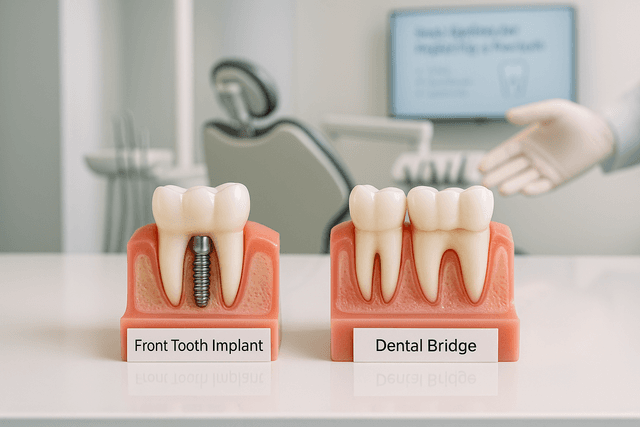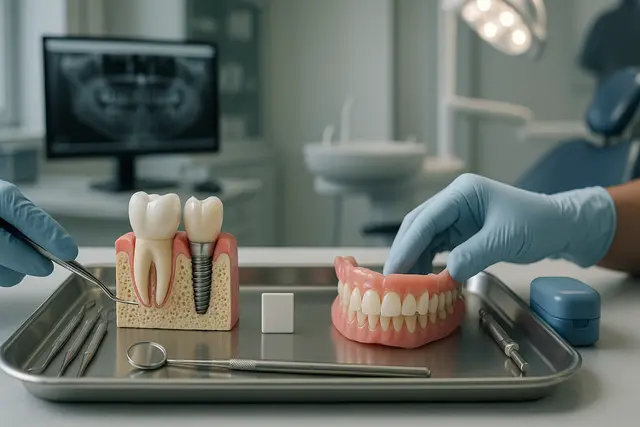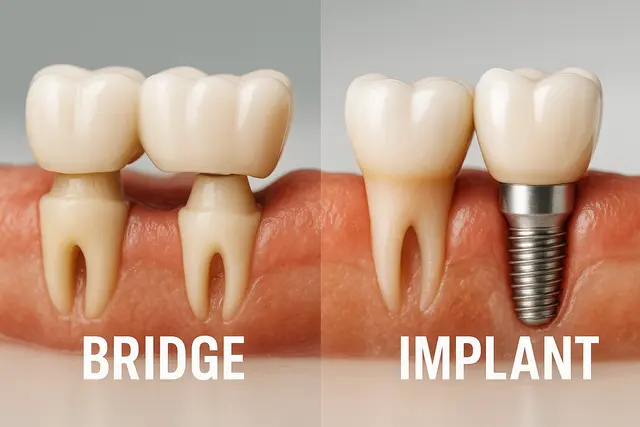Prosthodontics
6 min read
Aug 25, 2025
Front Tooth Implant vs. Bridge: The Best Choice for Your Smile
Losing a front tooth can be more than just a cosmetic concern, it can affect your speech, confidence, and daily comfort. Fortunately, modern dentistry offers reliable solutions like dental implants and bridges to restore both function and appearance. Choosing between them starts with understanding how each option works and what makes them unique.

Dental Implant: What Makes It a Top Choice for Front Teeth
Losing a front tooth is a big deal. It’s not just about chewing or speaking. It’s your smile, your confidence, your first impression. That’s why many people consider a dental implant to replace a missing tooth, especially in the front.
So what exactly is a dental implant? It’s basically a high-tech tooth root. After tooth loss, a small titanium post (the implant post) is placed into your jawbone where your original tooth used to be. This post fuses with the bone (yes, your bone actually grows around it), creating a sturdy base for a natural-looking crown on top.
Dental implants tend to feel just like your natural teeth. You can eat, laugh, talk, and grin without giving it a second thought. No slipping, no clicking, no awkward moments.
But here’s the kicker: implants are generally more expensive upfront, and they do require a bit of healing time. You might need a few months for the implant to fully integrate with your bone before the final crown goes on. Still, implants can last longer than bridges, often decades with proper care.
Dental Bridge: Still a Reliable Way to Restore Your Smile
A dental bridge has been the go-to tooth replacement option for decades. It’s less invasive than implants and can restore your smile in a matter of weeks rather than months.
Here’s how it works. A bridge fills the gap left by missing teeth using artificial teeth (called pontics) that are supported by crowns placed on the adjacent teeth. So if you lost one tooth, the dentist will shave down the neighboring teeth, fit them with crowns, and use them to support the bridge.
There are several types of dental bridges, including the traditional dental bridge, cantilever bridge, and the Maryland bridge. A Maryland bridge is often used for front teeth and attaches to the back of your existing teeth with metal or porcelain wings. It’s less damaging to your surrounding teeth, but it’s not always sturdy enough for high-pressure chewing.
Bridges typically last 10 to 15 years, and they’re usually quicker and more budget-friendly upfront compared to implants. However, if the bridge is not properly maintained, it can lead to issues like decay beneath a bridge or stress on supporting teeth.
Pros and Cons: What to Know Before Deciding
Here are the real pros and cons of dental implants and bridges:
Dental Implant Pros:
Looks and feels like a real tooth
Preserves bone structure by replacing the tooth root
Doesn’t rely on adjacent teeth
Can last a lifetime
Easy to care for, just like natural teeth
Dental Implant Cons:
Higher upfront cost
Requires surgery and healing time
Dental implants require healthy bone
Risk of implant failure in rare cases
Dental Bridge Pros:
Faster procedure
Lower upfront cost
No surgery required
Dental Bridge Cons:
Bridges may require grinding down healthy teeth
Doesn’t replace the tooth root
Bridges typically last a shorter time than implants
Bridges can also increase the risk of tooth decay
May not be strong enough for some bite pressures
Knowing the pros and cons of dental treatment helps you make a smart, personalized decision that fits your lifestyle, budget, and health.
Bridges or Implants: Which One Looks and Feels More Natural?
If you’re all about the aesthetics, dental implants win the beauty contest. A well-placed implant for front teeth can be practically indistinguishable from your real teeth. The crown is custom-made to match your exact shape and color.
Dental bridges can look great too, but since they sit on top of the gums and are connected to other teeth, the appearance may not be as seamless, especially as the gum line changes over time.
As for feel, implants feel more like your own teeth because they’re anchored into your bone. Bridges, while functional, can sometimes feel like a unit sitting on top of other teeth.
Dental Bridge or Implant: Which One Is Gentler on Neighboring Teeth?
This one’s big. Dental implants are self-supporting. They don’t touch your adjacent teeth, which means you’re not weakening perfectly good chompers to fix a gap.
In contrast, bridges typically rely on abutment teeth, the ones next to the gap, to support the bridge. If those supporting teeth aren’t strong enough to support a bridge, the entire structure could fail. Over time, bridges may even put stress on neighboring teeth, increasing the risk of tooth decay or fracture.
If you’ve got healthy adjacent teeth, you might think twice about grinding them down to fit a bridge.
Tooth Replacement: Why It Matters More Than You Think
Losing even one tooth, especially a front one, can lead to more than a shy smile. The gap left by missing teeth can cause surrounding teeth to shift, your bite to change, and bone loss in the jaw. Not to mention the confidence hit when you're dodging every camera or covering your mouth to laugh.
A dental implant helps by replacing the tooth root, keeping your jawbone active and healthy. That’s one big reason why dental implants may offer long-term health benefits beyond just looks.
Implants and Bridges: Maintenance and Daily Life
Implants are low maintenance. Brush, floss, routine checkups, you’re good to go. They don’t decay, though the gums around the implant still need TLC to avoid infections.
Bridges require a bit more finesse. Food can sneak under the bridge, and cleaning around the abutment teeth takes some skill. If you’re not meticulous, the bridge is not properly maintained and could fail earlier than expected.
So if you’re someone who tends to rush through brushing or forgets to floss, a dental implant might save you headaches (and cash) down the road.
Tooth Replacement Option: Comparing Durability and Cost
Here’s the deal: implants can last a lifetime. Seriously. While nothing’s guaranteed, many implants last 25+ years. Dental bridges typically last 10 to 15 years if cared for properly. So over a lifetime, you may need to replace a bridge once or twice.
But implants cost is generally more expensive upfront. The cost of a dental bridge is usually lower, and some dental insurance plans are more likely to cover bridges than implants. Implants require surgery and healing, which adds to the overall investment. Still, long-term, implants may end up being more cost-effective.
Want to get the most out of your dental restoration? It pays to think beyond just the initial bill.
Dental Bridge vs. Implant: How to Choose Based on Your Situation
If you’re missing one tooth and your adjacent teeth already need crowns, a bridge could be a great, fast solution. If your jawbone isn’t healthy enough to support the implant post, or you’re not ready for surgery, bridges are a solid fallback.
But if you want a solution that protects your jawbone, doesn’t mess with your surrounding teeth, and feels like the real deal, dental implants tend to be the better long-term move.
Candidates for dental implants usually need healthy gums, good bone density, and a commitment to oral hygiene. If that’s you, a single tooth implant may be the closest thing to getting your original tooth back.
Implant for Front Teeth: What to Expect During the Process
Getting a front tooth implant isn’t an overnight fix, but it’s worth the journey. Your dentist will assess your bone, possibly take a CT scan, and plan exactly where to place the implant. Once placed, you’ll wait a few months while the implant fuses with your bone.
Then comes the fun part: the crown. It’s carefully crafted to match your other teeth. Before you know it, that missing front tooth is ancient history.
During healing, you might get a temporary crown so you’re not stuck avoiding selfies.
Dental Bridges: When They’re Not the Best Pick
While dental bridges and dental implants both restore smiles, there are a few scenarios where bridges may not be ideal. If the abutment teeth aren’t strong, or if there’s not enough space, bridges may not hold up. And if the supporting teeth weaken or if the bridge is not properly maintained, you might be back in the dental chair sooner than you’d like.
Also, keep in mind that Maryland bridges can sometimes come loose, especially if you bite into hard foods. Not ideal for your daily apple-a-day habit.
What Makes a Dental Implant a Good Choice for Front Teeth?
Dental implants are often considered the gold standard for replacing a missing front tooth because they mimic the natural tooth structure. A titanium post is surgically placed into the jawbone, where it fuses with the bone to provide a stable base for a custom-made crown. This makes the implant look and feel like a natural tooth while also preserving jawbone health by stimulating bone growth. Though they require surgery and a healing period, implants can last decades with proper care.
How Do Dental Bridges Work for Replacing a Front Tooth?
A dental bridge restores your smile by using artificial teeth (pontics) supported by crowns on the adjacent teeth. For a single missing front tooth, a Maryland bridge may be used, which attaches to the back of neighboring teeth with wings instead of crowns. Bridges offer a quicker, less invasive option compared to implants and typically cost less upfront. However, they may require grinding down healthy teeth for support and generally last 10 to 15 years, which is shorter than implants.
Which Option Looks and Feels More Natural: Implant or Bridge?
Dental implants generally provide the most natural look and feel. Because the implant is anchored in the bone, the crown blends seamlessly with your other teeth and feels stable while eating or speaking. Bridges can also look attractive, but over time changes in the gumline or stress on supporting teeth may affect their appearance. Functionally, implants feel more like natural teeth, while bridges may sometimes feel like a single unit resting on top of other teeth.
What Factors Should You Consider When Choosing Between an Implant and a Bridge?
The decision depends on your oral health, budget, and long-term goals. Implants are ideal if you want a durable, bone-preserving option and are healthy enough for surgery with adequate bone density. Bridges may be better if you need a quicker, less invasive solution or if your adjacent teeth already need crowns. Cost is another factor, bridges are more affordable initially, but implants may be more cost-effective over a lifetime since they rarely need replacement.
Read Next
Related Posts

Prosthodontics
Implant vs. Dentures Pros and Cons: A Deep Dive into Modern Solutions
Missing teeth can impact more than just your smile, they can affect how you eat, speak, and feel about yourself. Fortunately, modern dentistry offers two leading solutions to bring back both function and confidence: dentures and dental implants. Understanding the pros and cons of each can help you make the choice that fits your needs, lifestyle, and budget.
7 min read
Oct 17, 2025

Prosthodontics
Full Mouth Implants vs. Dentures: Which Is Better for You?
When it comes to replacing missing teeth, the choice between full mouth dental implants and dentures can be overwhelming. Each option has its own set of benefits, limitations, and long-term considerations, making it essential to understand what works best for your needs, health, and lifestyle.
5 min read
Oct 17, 2025

Prosthodontics
Tooth-Supported Bridge vs. Implant Comparison: Benefits, Drawbacks, and Insights
Deciding between a dental bridge and a dental implant can feel overwhelming, especially when both options promise to restore your smile and improve oral function. Each solution comes with its own set of benefits, considerations, and ideal use cases, making it essential to understand how they compare before choosing what’s right for you.
6 min read
Oct 17, 2025
Don’t have time to research every dentist around you?
See why 30k+ patients trusted us